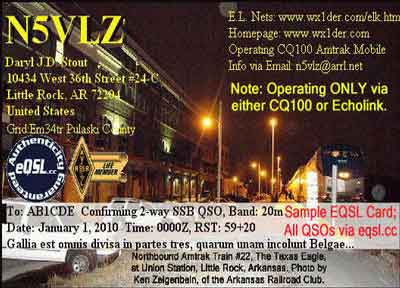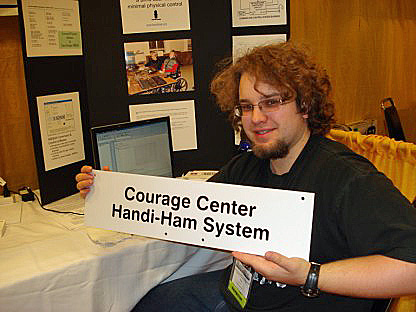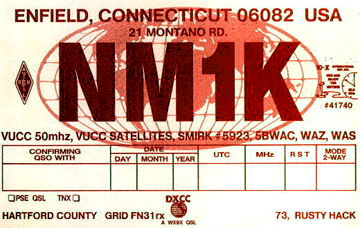Welcome to Handiham World!
 Have you ever taken your place at the head of a classroom and taught a course about amateur radio? I know some of you probably have. Others of you may be thinking, "I wouldn't know how to begin to teach."
Have you ever taken your place at the head of a classroom and taught a course about amateur radio? I know some of you probably have. Others of you may be thinking, "I wouldn't know how to begin to teach."
Sure, you may be blind or use a wheelchair, but that doesn't mean you can't be part of your local radio club's team of educators. In fact, one of the best ways to keep amateur radio healthy in your community is to make sure that regular classes are taught for the beginner license. Now, here's the thing with clubs: It is too easy for most of the club members to just sit around and let a few really gung-ho members do all the club's work, whether it be teaching classes, writing the news letter, getting club programs together, arranging for meeting space, and all the rest. Clubs that call on help from all the members, each doing some of the work to which they are suited, will do best in the long run.
I'd like to challenge you to be a teacher, and to share your experiences with us. A good place to start is a publication you may not even know about, but I'll bet your club's educational coordinator does: The ARRL Instructor's Manual edited by Mark Spencer, WA8SME. I've got both the Third and Fourth editions, and was happy to see the chapter by Peter Kemp, KZ1Z, carried over to the Fourth edition. In this important chapter, KZ1Z gives us "The Teacher's Guide to Amateur Radio Instruction".
Starting with the very basics, this fine article covers every aspect of teaching, beginning with the questions you may have as a prospective teacher: What is a teacher? Who can teach? How does one organize a class? Becoming a ham radio instructor and organizing a class may seem like overwhelming tasks, but remember that you can accomplish them if you just break them down into smaller steps, each of which you know you can complete. As a former public school teacher myself, I know that I can use a good reference on setting up and running a class. No one, even experienced teachers, will turn down an opportunity to learn more about teaching, so that they can become even better at it!
One slip-up that new teachers make is failing to put together a "lesson plan". Thankfully, KZ1Z gives us a complete list of what a good lesson plan should include. There is nothing like having a lesson plan in hand to give the new teacher confidence as they walk (or roll) up to the front of that classroom! In fact, we use lesson plans at Radio Camp sessions. As an example, let's say that the course we are teaching is one in Operating Skills, and the topic for that morning is "Diagnosing a Problem With the HF Rig". Your lesson plan would include specific objectives for the student, such as:
- Find and reconnect a disconnected power cable or antenna
- Turn on a power supply
- Determine when a mode switch is set wrong and correct it
- Determine when a filter setting is wrong and correct it
...and so on. You get the idea. What we want to do is know what specific skills the student will know once the lesson is completed. This makes it easier for you, the teacher, to stay focused on the job you need to do. It's surprising how much more smoothly your teaching will go if you take the time to learn these basics from the ARRL Instructor's Manual.
Blind handiham members may be interested in the KZ1Z chapter. If so let me know and we will see if we can get it read into special audio for our members. You can get your own copy of the print book on the ARRL website. It is publication number 256.
Patrick Tice
wa0tda@arrl.net
Handiham Manager
Now, back to our vintage QSL card series.

Hey, what gives? This is no vintage card! It's a sample card from N5VLZ, and the theme is AMTRAK mobile. The card shows a train pulling into a station at night, with platform lights illuminating the side of the train. Very cool!
 If you have been an amateur radio operator for quite a long time, you know that there is an ebb and flow to ham radio activities and interests. There is a clear seasonal difference between summertime amateur radio and wintertime amateur radio. As a teenager, I was extremely busy during the summertime, because I enjoyed experimenting with antennas. Conditions might not have been the best for long-distance communications on the lower HF frequency bands, but that didn't matter to me. Other amateur radio operators simply hung up their headphones until the cool, crisp days of autumn brought them back into their ham shacks. During the hottest weeks of summer, even antenna work was problematic for me. The local ham radio club suspended meetings during the summer anyway, so it was truly the "dog days of summer". Even today, decades later, many radio clubs still follow the same pattern of taking the summer off. People want to get outdoors and enjoy summer activities, band conditions are generally poor, aside from sporadic E-skip, and (even worse) we are stuck at the very bottom of the sunspot cycle with new cycle 24 taking its sweet time getting started.
If you have been an amateur radio operator for quite a long time, you know that there is an ebb and flow to ham radio activities and interests. There is a clear seasonal difference between summertime amateur radio and wintertime amateur radio. As a teenager, I was extremely busy during the summertime, because I enjoyed experimenting with antennas. Conditions might not have been the best for long-distance communications on the lower HF frequency bands, but that didn't matter to me. Other amateur radio operators simply hung up their headphones until the cool, crisp days of autumn brought them back into their ham shacks. During the hottest weeks of summer, even antenna work was problematic for me. The local ham radio club suspended meetings during the summer anyway, so it was truly the "dog days of summer". Even today, decades later, many radio clubs still follow the same pattern of taking the summer off. People want to get outdoors and enjoy summer activities, band conditions are generally poor, aside from sporadic E-skip, and (even worse) we are stuck at the very bottom of the sunspot cycle with new cycle 24 taking its sweet time getting started. Now, back to our vintage QSL card series. Today we have a card from Rusty, NM1K. Guess what? I'll bet you can still get one of these cards from Rusty, who sends out many NTS birthday messages to handiham members and friends. Work Rusty on the air and QSL to get one of these beauties. Thanks, of course, to Rusty for all of his good work with NTS, the National Traffic System.
Now, back to our vintage QSL card series. Today we have a card from Rusty, NM1K. Guess what? I'll bet you can still get one of these cards from Rusty, who sends out many NTS birthday messages to handiham members and friends. Work Rusty on the air and QSL to get one of these beauties. Thanks, of course, to Rusty for all of his good work with NTS, the National Traffic System.